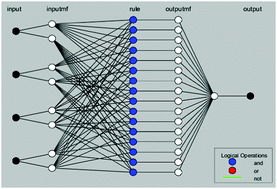当前位置:
X-MOL 学术
›
New J. Chem.
›
论文详情
Our official English website, www.x-mol.net, welcomes your feedback! (Note: you will need to create a separate account there.)
Sonochemistry: a good, fast and clean method to promote the removal of Cu(ii) and Cr(vi) by MWCNT/CoFe2O4@PEI nanocomposites: optimization study
New Journal of Chemistry ( IF 3.3 ) Pub Date : 2018-08-28 00:00:00 , DOI: 10.1039/c8nj03277g Mohammad Hassan Omidi 1, 2, 3, 4, 5 , Mohammad Hossein Ahmadi Azqhandi 5, 6, 7, 8, 9 , Bahram Ghalami-Choobar 1, 2, 3, 4, 5
New Journal of Chemistry ( IF 3.3 ) Pub Date : 2018-08-28 00:00:00 , DOI: 10.1039/c8nj03277g Mohammad Hassan Omidi 1, 2, 3, 4, 5 , Mohammad Hossein Ahmadi Azqhandi 5, 6, 7, 8, 9 , Bahram Ghalami-Choobar 1, 2, 3, 4, 5
Affiliation

|
In this study, branched polyethylenimine (PEI) loaded on magnetic multiwalled carbon nanotubes (MWCNT/CoFe2O4) was synthesized and characterized by transmission electron microscopy (TEM), field emission scanning electron microscopy (FESEM), X-ray diffraction (XRD), Brunauer–Emmett–Teller (BET) analysis and Fourier transform infrared spectroscopy (FTIR). The isotherms and kinetic behavior of the adsorption of Cu(II) and Cr(VI) onto MWCNT/CoFe2O4@PEI were explained by pseudo-second-order kinetic and extended Freundlich models. The adsorption performance was analyzed by an adaptive neuro-fuzzy inference system (ANFIS), a generalized regression neural network (GRNN) and response surface methodology (RSM) and compared. The influence of process variables (the sonication time, initial concentration of cations, and adsorbent mass) on the removal of Cu(II) and Cr(VI) was considered by central composite rotatable design using RSM, GRNN and ANFIS. All the models were statistically compared with the root mean square error (RMSE), coefficient of determination (R2), absolute average deviation (AAD) and mean absolute error (MAE) based on the validation dataset. The coefficients of determination (R2) calculated from the validation data for the ANFIS, GRNN and RSM models were 0.9995, 0.9978 and 0.9647 for Cu(II) and 0.9992, 0.9949 and 0.9567 for Cr(VI) ions, respectively. The ANFIS model was found to be more precise in comparison with the other models. However, it was demonstrated that GRNN is much easier than the ANFIS method and needs less time for analysis. Hence, it has good prospects in chemometrics, and it is feasible that the GRNN algorithm could be applied to model real systems. The monolayer adsorption capacities for Cu(II) and Cr(VI) ions were 510.200 and 490.220 mg g−1, respectively.
中文翻译:

声化学:MWCNT / CoFe 2 O 4 @PEI纳米复合材料促进去除Cu(ii)和Cr(vi)的好方法,快速清洁方法:优化研究
本研究合成了负载在磁性多壁碳纳米管(MWCNT / CoFe 2 O 4)上的支链聚乙烯亚胺(PEI),并通过透射电子显微镜(TEM),场发射扫描电子显微镜(FESEM),X射线衍射(XRD)对其进行了表征。 ),Brunauer–Emmett–Teller(BET)分析和傅立叶变换红外光谱(FTIR)。MWCNT / CoFe 2 O 4上Cu(II)和Cr(VI)的吸附等温线和动力学行为。@PEI用伪二级动力学模型和扩展的Freundlich模型进行了解释。通过自适应神经模糊推理系统(ANFIS),广义回归神经网络(GRNN)和响应面方法(RSM)对吸附性能进行了分析并进行了比较。通过使用RSM,GRNN和ANFIS的中央复合旋转设计,考虑了工艺变量(超声处理时间,阳离子的初始浓度和吸附剂质量)对去除Cu(II)和Cr(VI)的影响。基于验证数据集,将所有模型与均方根误差(RMSE),确定系数(R 2),绝对平均偏差(AAD)和平均绝对误差(MAE)进行统计比较。确定系数(根据ANFIS,GRNN和RSM模型的验证数据计算得出的R 2),对于Cu(II)分别为0.9995、0.9978和0.9647,对于Cr(VI)离子分别为0.9992、0.9949和0.9567 。发现ANFIS模型与其他模型相比更为精确。但是,事实证明,GRNN比ANFIS方法容易得多,并且所需的分析时间更少。因此,在化学计量学方面具有良好的前景,将GRNN算法应用于实际系统的建模是可行的。Cu(II)和Cr(VI)离子的单层吸附能力分别为510.200和490.220 mg g -1。
更新日期:2018-08-28
中文翻译:

声化学:MWCNT / CoFe 2 O 4 @PEI纳米复合材料促进去除Cu(ii)和Cr(vi)的好方法,快速清洁方法:优化研究
本研究合成了负载在磁性多壁碳纳米管(MWCNT / CoFe 2 O 4)上的支链聚乙烯亚胺(PEI),并通过透射电子显微镜(TEM),场发射扫描电子显微镜(FESEM),X射线衍射(XRD)对其进行了表征。 ),Brunauer–Emmett–Teller(BET)分析和傅立叶变换红外光谱(FTIR)。MWCNT / CoFe 2 O 4上Cu(II)和Cr(VI)的吸附等温线和动力学行为。@PEI用伪二级动力学模型和扩展的Freundlich模型进行了解释。通过自适应神经模糊推理系统(ANFIS),广义回归神经网络(GRNN)和响应面方法(RSM)对吸附性能进行了分析并进行了比较。通过使用RSM,GRNN和ANFIS的中央复合旋转设计,考虑了工艺变量(超声处理时间,阳离子的初始浓度和吸附剂质量)对去除Cu(II)和Cr(VI)的影响。基于验证数据集,将所有模型与均方根误差(RMSE),确定系数(R 2),绝对平均偏差(AAD)和平均绝对误差(MAE)进行统计比较。确定系数(根据ANFIS,GRNN和RSM模型的验证数据计算得出的R 2),对于Cu(II)分别为0.9995、0.9978和0.9647,对于Cr(VI)离子分别为0.9992、0.9949和0.9567 。发现ANFIS模型与其他模型相比更为精确。但是,事实证明,GRNN比ANFIS方法容易得多,并且所需的分析时间更少。因此,在化学计量学方面具有良好的前景,将GRNN算法应用于实际系统的建模是可行的。Cu(II)和Cr(VI)离子的单层吸附能力分别为510.200和490.220 mg g -1。

























 京公网安备 11010802027423号
京公网安备 11010802027423号